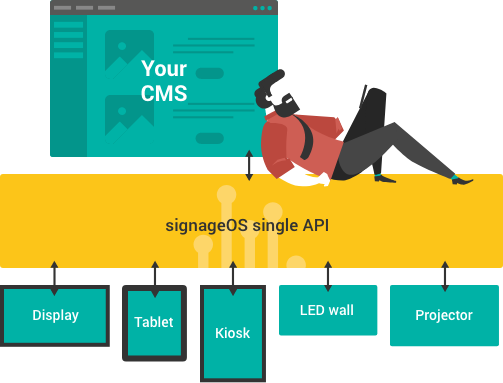
SignageOS Launches Software Bridge For Digital Signage On Raspberry Pi
October 11, 2018 by Dave Haynes
The Czech software start-up signageOS has launched a software platform that enables established CMS software companies to add low-cost Raspberry Pi micro PCs to its range of media player options, without having to assign the necessary development resources to figure it all out and get it running.
The custom integration by the Prague company – which already has what it calls a unification platform for the many smart displays on the market – works for the Pi as a standalone player or using the embedded Compute Module that snaps into the backs of certain NEC Large Format Displays.
The principal attraction of the Pi is a PC that in barebones form costs less than $50, and all kitted up with a case and so on $100-$200, depending on how that’s done.
The Pi players use a custom Linux core developed by signageOS, and optimized for digital signage. “The signageOS team has spent several months working hard to deliver a seamless experience with the Raspberry Pi for our CMS partners. A lot of heavy lifting was done in order to push Rpi to its limits, including crafting custom Linux distribution along with custom Chromium, node.js and native player development,”says Stan Richter, CEO of signageOS.
Says a press release:
Leveraging the power of Raspberry Pi for digital signage, examples of features included with the signageOS API are:
- Gapless video playback and live streaming
- API for device control (reboot, timer scheduling, etc.)
- All screen orientation support
- Remote live screenshots
- Cloud integration with regular patches and upgrades
- Secure processing of sensitive software, patches, and upgrades signed by signageOS
The custom Raspberry Pi integration is suitable for 90% of all digital signage installations. Now, CMS companies have the option to create inexpensive and entry to medium-level digital signage installations using the low-cost Raspberry Pi technology through signageOS, while maintaining the high-performance level and meeting the customer’s needs. This fully functional integration includes every management and monitoring feature listed in the signageOS features list.
Interesting move. At least in theory, it allows a number of software companies that have looked at the Pi (or more likely had clients bugging them about it) to adopt the hardware. SignageOS makes its money by being in the middle of the application, so users see their chosen CMS as the front-end but the application routs through the Signageos platform to make things happen, charging a low-cost subscription fee.
There are not that many companies currently using the Pi – with the most notable being London’s Screenly, which only does the Pi platform, and Silver Curve, also from London, which among a few projects has Pis running the screens at the famed Lord’s Cricket Grounds.



Leave a comment